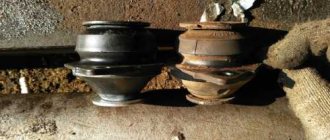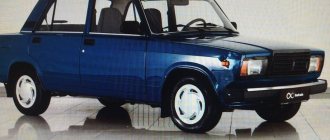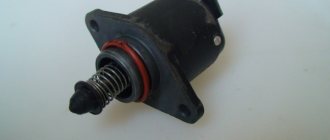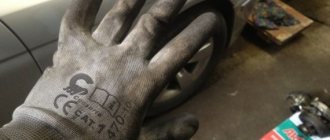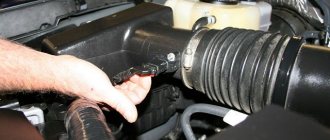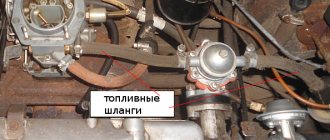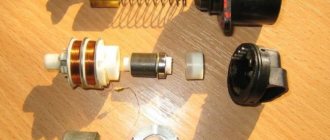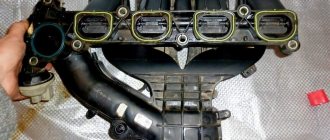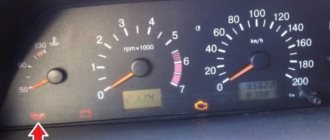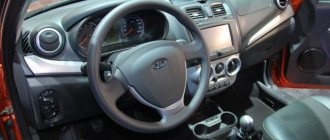Signs of unstable operation of the VAZ-2114 engine at idle
The first thing that catches your eye is vibration. Indeed, it is impossible not to notice it - it is transmitted to the steering wheel, to the gearshift lever, and sometimes the entire body begins to vibrate. Not only is vibration itself not the most pleasant phenomenon, it can signal a breakdown or the need for maintenance of many components and systems.
Causes of engine vibration VAZ-2114
If the engine operates quite normally in transient modes and at medium and high speeds, do not rush to draw conclusions about the malfunction of the idle system. First of all, let’s analyze the symptoms, and they can be like this:
- After starting, the engine vibrates when cold, and the speed can fluctuate from 800 to 2000 revolutions spontaneously. In this case, after warming up, vibration may be absent and the idle will be in the normal range, 800-850 rpm.
- After the engine warms up, the vibration does not disappear.
- When cold the idle is normal, after warming up the speed fluctuates and the engine knocks.
- The idle may disappear while driving, when coasting or at an intersection after a short vibration. In this case, you can catch the speed with the accelerator pedal.
VAZ-2114. If you don't adjust the valves, it will vibrate!
In short, any engine vibrations at idle require the most prompt diagnosis. And we will check those systems and components that can lead to malfunction most often.
Rubber
There are often cases when vibration when accelerating appears due to the installation of low-quality tires. Most often these are tires from budget and extra-budget manufacturers. The peculiarity of such rubber is that when checking on a balancing stand, a discrepancy that causes discomfort when driving a car may not be noticed. In the second case, balancing only temporarily delays the reappearance of vibrations. Only replacing the tires will solve the problem.
The next reason for the appearance of unwanted vibrations is typical for owners whose car is shod with low-profile tires. The side cord of such tires does not have the rigidity and elasticity that is inherent in civilian versions of tires. Therefore, prolonged downtime, especially in the warm season, can cause temporary deformation of the tire at the point of contact with the road surface. Therefore, vibration during acceleration may be observed for a short time after the start of movement.
The first kilometers should be covered with extreme caution.
Uneven wear
Asymmetric wear of the tread on the tire and the appearance of “bumps” will lead to the fact that the suspension elements will experience additional vibration load. Of course, the whole car as a whole will vibrate at speed.
Wheel bearing
If at speed you not only vibrate, but also hear a hum, then you can say with confidence that the wheel bearing has failed. The situation is quite normal, so at the beginning of the problem, operating the car will not cause any consequences. But there’s no point in delaying repairs. Overly worn bearings can fly apart, which will certainly lead to disastrous consequences.
A malfunction of this unit is indicated by wheel play. To diagnose, hang up the wheels and shake each of them in the longitudinal and transverse directions. The play will be a signal for an immediate replacement.
Suspension and steering
Worn suspension elements cannot cause constant or periodic vibrations when driving. Their purpose is to dampen shocks that come from the road surface. Therefore, a car with a faulty suspension can scour the road, make squeaks or knocks when turning the steering wheel, or make dull or loud “echoes” of obstacles overcome.
To safely drive a car, it is worth solving the problem comprehensively.
Vibration at idle. At gunpoint - ignition
One of the main reasons for vibration at idle in an injection engine is incorrect operation of the ignition system.
Even in the case when the fuel-air mixture is supplied to the cylinder in the required quantity and on time, the passage of a spark, constant or periodic, will certainly lead to vibration. Moreover, at medium and high speeds the engine can operate stably, with nominal fuel consumption and good dynamics.
First of all, we check this:
- Any gaps in spark formation will lead to uneven emission of exhaust gases; you can check this simply by placing your hand near the exhaust pipe of the muffler; the gaps will be immediately audible.
A good engine should have uniform exhaust
- Breakdown in the high-voltage circuit. Initially, it is worth checking the high-voltage wires - they should not contact ground, both along the entire length and in places of contact with the coil and spark plug cap
Breakdown of high-voltage wires can cause engine vibration
- Candles. Quite often they can malfunction at low speeds due to a breakdown in the housing. In this case, a dark brown or black coating will be clearly visible along the rim of the insulator from below - the first sign that the spark plug is breaking through to ground. You need to check each spark plug - while idling, you need to remove the caps one by one and listen to see if the engine operation has changed. Faulty spark plugs must be replaced (see “selection of spark plugs for the VAZ-2114 - parameters and clearances”).
We check the spark plugs by removing the caps one by one
- Malfunction of the ignition coil (ignition module). In this case, you can check the functionality only by replacing the module or coil with a known working one.
Changing the ignition module
In addition to these problems, difficulties may arise in the operation of electronics; this mainly applies to injection engines. And only these were installed on the VAZ-2114, with the exception of the Samar-2 line being the VAZ-2115 - there were carburetor versions.
Answers:
— Measure the compression in the cylinders, it should be the same.
— eliminate the floating of revolutions, this is a common phenomenon (vibration, that is) in this situation.. how? This is a separate topic, a lot has been written about this, but the compressor and ignition are usually not relevant here... use the search, it’s a million..
— There are a million reasons... from the spark plugs that you changed... new ones do not mean that they are working... to the engine mounts... Just look and check, in short, look and only... Two days ago I changed the spark plugs to a new set... everything seems to work. But something is wrong... in the end the spark plug the second cylinder even in color...replaced the ass with an old one but it’s working and in order...this is an example...
— They measured the compression... the master said it was ideal. But of course he could have deceived me... It’s just that the tachometer needle twitches quite a bit, so I didn’t think that IAC, for example, was guilty. Yes, and a computer. the diagnostics showed nothing (The service center where all this work was carried out said that vibration is normal and it would take too long to find the cause. But I don’t agree with them... They also say that there are valves in the oil filter that prevent oil from draining into the crankcase They don’t know anything! And when I came to them with the problem of the oil can going out 2 seconds after the start, they said that the filter could not possibly be in use. Post edited by JokerOK: July 10, 2011 - 08:48
— Rinse the throttle body with carb fluid, it’s better, of course, to completely remove the unit, at the same time clean the IAC valve, and wash the valve jet, and the damper itself and the channels...
— The same nonsense, the speed and vibration fluctuate a little, although the car is new and only has 600 km of mileage!!!
— I would go under guarantee if I were you. Let them fix it, this is not the case on a new car!
- I had the same crap. If you have 1.6, then air leaks through the plastic receiver are possible. It consists of two halves, I had gaps between them. There was also a suction through the mass air flow sensor, bypassing the filter, the mass air flow sensor was covered in dust. Someone’s hands could have been torn off. It could be from anything: spark plugs, ignition valves, explosive wires, fuel system, valves. Message edited by m104: August 16, 2011 - 10:10
Based on materials from the Lada Forum: lada-forum.ru
Electronics and sensors as causes of vibration
Another suspect in the story of engine vibration at idle is the electronic engine control unit. No one will repair it; most often it must be either replaced or re-flashed. For example, in injection engines with a Bosch 7.9.7+ controller, flashing ER19 instead of the standard ER16 often helps, fuel consumption remains within normal limits, and vibration disappears.
In addition to the ECU, the following sensors may be to blame:
- Idle speed regulator. The regulator sensor is mounted on the throttle body, and to check it you need to remove the terminals and use a multimeter in ohmmeter mode to check the resistance between the contacts. The nominal value is 60-80 Ohms. If the sensor does not produce the required resistance, replace it with a new one.
Checking the idle air control
- Mass air flow sensor. If this sensor malfunctions, the pulse it sends to the ECU will have an incorrect value, therefore, the engine may vibrate at idle. The sensor is checked in the same way as the previous one, but the multimeter is set to voltage measurement mode. With the ignition on and the engine off, the voltage between the sensor contacts should be within 0.9-1 V.
Checking the mass air flow sensor
- EGR sensor. It is responsible for the recovery of exhaust gases and is an electromagnetic cone valve. It is this valve that requires periodic cleaning. We carry out cleaning with any spray for washing the carburetor or injectors.
Checking the spark plugs
It is better to start checking the system with spark plugs. First of all, you need to start the engine and warm it up to operating temperature. Then you need to set the minimum idle speed (from 800 to 1000, depending on the engine type). If the engine runs rough and vibrations appear, then you need to check the spark plugs. This is done quite simply - you need to remove the caps of the candles one by one. If, when removing the cap, the engine begins to vibrate even more strongly or stalls completely, this spark plug and its high-voltage wire are in good condition. Having returned everything to its place, you need to check the remaining spark plugs. If, when the cap is removed, the engine operating mode remains unchanged, it means that the cylinder for which this spark plug is responsible does not work, that is, the fuel in it does not ignite.
To solve this issue, you need to inspect the spark plug itself, its high-voltage wire and distributor. A common problem with spark plugs and wires is breakdown, in which part of the electricity simply goes to ground. This is usually accompanied by a subtle spark.
To check the serviceability of the spark plug, you need to:
- Remove all caps.
- Unscrew the non-working spark plug.
- Put a cap on it.
- Place the spark plug on a surface that has contact with the vehicle's ground (for example, a valve cover).
- Ask an assistant to turn on the ignition and idle the starter.
- Check for spark at the spark plug.
When the starter rotates, a stable bluish spark appears between the electrodes of a working spark plug. If it is missing or has a yellow tint, it means the candle has become unusable. Checking the spark plug only takes place if the wire and distributor are known to be working.
If vibration occurs in the cabin at idle, it is advisable to check the serviceability of all spark plugs
In addition to the integrity of the latter, it is important to pay attention to the presence of deposits and carbon deposits on their electrodes. They can also cause a weak spark. It is imperative to make sure that the gap between the spark plug electrodes is equal to the value specified by the machine manufacturer
It is imperative to make sure that the gap between the spark plug electrodes is equal to the value specified by the machine manufacturer.
Other causes of vibration at idle
Of course, you should not ignore the power system, and first of all, the injectors and throttle. The throttle must completely block the diffuser, and to clean it, aerosol compositions are used, the same as in the case of the EGR sensor.
Cleaning the throttle valve
The performance of the injectors is checked on a stand, and they are cleaned if necessary. In addition, vibrations at idle speed can occur due to excessive wear or failure of the engine mount. The cushion consists of two brackets, one of which is attached to the engine cylinder block, and the second to the body. The brackets are connected to each other by a rubber silent block and a vibration damping cushion. It may crack, crumble, or simply tear. Hence the vibrations at idle.
The engine mount can cause vibrations
Video about the reasons for unstable operation of the VAZ-2114 engine
Replacing pillows and preventing spark plug malfunctions
It is worth learning to deal with the most common causes of body vibrations: engine mounts and spark plugs. In the first case, replacing parts cannot be avoided - the rubber from which the parts are made simply wears out and loses its elasticity. There's nothing you can do about it. Replacing pillows is similar to other car models and should not cause problems. To replace you will need:
- Socket wrench 17 with cardan.
- Socket wrench 13.
- Keys for 15 and 19.
- Hydraulic jack.
Read next: How to Clean the Throttle Body on an Accent
If replacing parts yourself causes you difficulties or you lack the necessary tools, the best solution would be to contact a car service center. At the same time, you can select the pillows you need in advance, so as not to wait for mechanics to find them and order them for you.
However, spark plugs, unlike engine mounts, can avoid replacement for a long time if they are properly cared for. If you regularly clean them and monitor the gap between the electrodes, you can significantly increase the period of stable operation without uncomfortable vibrations of the case.
Excess oil in the crankcase, insufficient vehicle load, early ignition - this may be indicated by different colored soot on the spark plugs. Paying attention to this detail can greatly help you diagnose problems.
Diagnostics of the vacuum brake booster
Checking the tightness of the system is quite simple. To begin with, with the engine turned off, you need to press the brake pedal 4-5 times at intervals of one second. At first it will fail, but after a few presses it will stop. Then you need to press the pedal and, without releasing it, start the engine. When the engine is turned on, the brake should move forward slowly. If he did not do this, then there is an air leak in the system.
Once you are sure that the vibrations are caused by the brake booster, you need to inspect the air hose. To do this, it is recommended to remove it by loosening the clamps securing it to the intake manifold and valve. The best way to check the integrity of the hose is by blowing. If the slightest air leak is detected, it must be replaced with a new one.
If everything is in order with the hose, then you need to check the serviceability of the check valve by removing it from the vacuum booster housing. To do this, it is recommended to use a rubber bulb placed on a fitting included in the vacuum body. By pressing on it, you need to release air through the valve. If everything is in order with the valve, air will flow out freely and not flow back. If you don’t have a bulb, you can simply blow into the wide fitting, and then into the narrow one. In the first case, the air should pass freely, and in the second, it should not pass at all. If a malfunction is detected in the check valve, it should be replaced.
Wheels are loose
This problem is easy to identify and fix, as it causes vibration at speeds of 100-120. The VAZ-2110 will make a characteristic dull sound. The problem is the loose nuts and bolts securing one wheel or several. Do not neglect checking, it can be dangerous. The wheel may simply unscrew while driving.
The beating itself is very reminiscent of vibrations on the steering wheel and body when the reason was in the wheels and tires. The difference here is that this shaking begins at low speeds. This phenomenon can be observed at different speeds.
So, we found out for what reasons vibration occurs on the body when driving at speeds of more than 100 kilometers per hour.
Subscribe to topic
Subscribe to this forum
Download/Print theme
Download the theme in various formats or view a printable version of the theme.
Any driver is very alarmed when vibration begins in the body at a speed of 100-120 km/h, and at any other speed in the same way. It's not so much a matter of unpleasant sensations, although they do occur. However, if urgent measures are not taken, long-term vibration begins to affect the geometry of the body - little by little, gradually, but steadily.
Distortion, in turn, leads to disruption of aerodynamics and worsens the car's handling. In addition, it is very likely that cracks will appear in the body - and welding work is one of the most expensive.
Moreover, vibration in any component of the car can cause nuts and bolts to spontaneously unscrew, which can lead to serious complications while driving, including accidents and damage that is difficult to repair. Let’s add here that such shaking can signal problems that are about to turn into breakdowns.
Valve timing fault
If vibration occurs in the cabin at idle, the first thing to check is whether the marks on the camshaft sprocket correspond with the marks on the engine cover. If they do not match, it means the valve timing has shifted. As a result, when the fuel mixture enters the cylinders, it ignites unevenly. In addition, it may not have time to burn completely. This leads to the fact that the engine loses power, begins to consume more fuel, smokes, and sometimes even stalls.
The displacement of marks occurs involuntarily. The main reasons for this are: stretching of the timing belt, incorrect tension, incorrect marking during repairs. The same problem can also occur in an engine with a timing chain drive, such as the Z22SE engine. Vibration in the cabin at idle in a car with this power plant occurs due to poor design of the chain and oil nozzle in the timing drive. As a result of the hydraulic tensioner jamming, it ceases to perform its functions and the chain begins to deform.
In an engine with a timing belt, the problem is solved by combining the above marks, which cannot be said about engines like Z22SE. Vibration in the cabin at idle speed in such power plants can be eliminated, as a rule, only by replacing the hydraulic tensioner, and sometimes the entire timing belt kit.
Breakdown of the vacuum brake booster
As practice shows, not all car owners can associate the braking system with engine vibrations. In fact, brake malfunction often causes vibration processes. Before we find out how such a breakdown is diagnosed, let’s understand its origin.
The vacuum brake booster is connected to the engine intake manifold via a check valve and hose. The last two elements are designed to create a vacuum in the amplifier. This occurs due to the rarefaction of air formed in the intake manifold during the movement of the pistons. Simply put, the check valve sucks air out of the amplifier. If the tightness of the valve or hose is broken, then more air enters the manifold than necessary. This leads to a lean fuel mixture.

